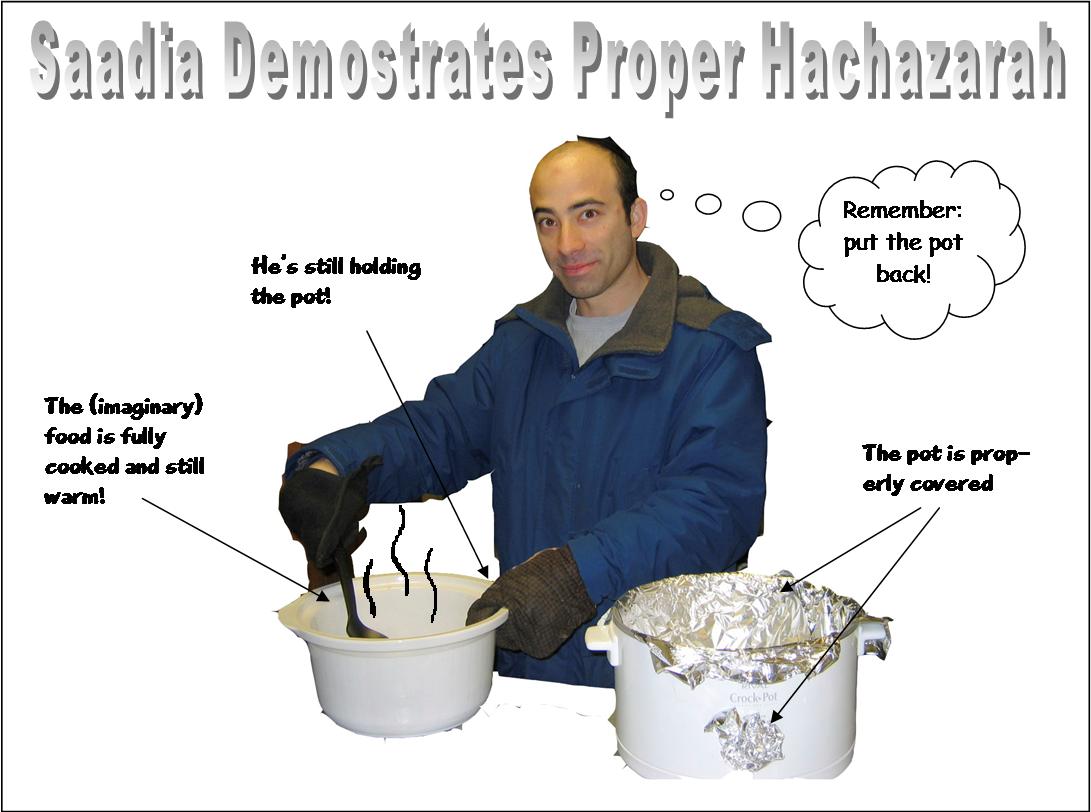שהייה (Shehiyah) – Leaving Food on the Fire
The Torah forbids us from cooking on Shabbos. This prohibition includes putting uncooked items on a fire, and also raising the temperature of food already cooking on the fire. Realizing that no one likes burnt cholent, the rabbis feared that if you came home from shul on Friday night and realized that your cholent wasn’t hot enough to cook properly, you might inadvertently stoke the coals of the fire (or raise the temperature on your stove, oven or crock pot). Therefore, they prohibited us from leaving partially cooked food on an open fire once Shabbos began. But, they gave us a number of options:
1. Cover the fire. That way, if you see the covering, you’ll remember not to touch that fire on Shabbos. On a crock pot, this entails putting a piece of tin foil between the insert and the heating element and also covering the knob. On a stove, it involves putting a blech over the heating element.
2. Once the food is sufficiently (at least one-third) cooked, you can leave the food on the flame, because you won’t be tempted to adjust the fire. So, if you’re up at the lake during the summer, and you don’t have a blech with you, as long as you heat up your soup before Shabbos, you can leave it on a low flame on Shabbos. Still, whenever possible, it’s always a good idea to cover the flame you’re using on Shabbos.
החזרה (Hachazarah) – Returning Food To A Fire
It’s a long, cold Friday night. Following the rabbi’s advice, I fully cooked my cholent before Shabbos, and even put the foil between the heating element and the insert and covered the knob. It’s now stewing peacefully on a low flame. About an hour after dinner, my cholent calls to me. At first it’s only a whisper, but as the night progresses, it grows progressively louder. “Taste me. Have some now! Don’t wait until tomorrow!” I feel like I’m trapped in an Edgar Allen Poe poem. I have to eat some cholent. But wait! I know that I can’t take food from a pot while it’s still on the flame. (I would inadvertently stir the food, which would enhance the cooking process. Bad.) But, if I take the cholent off the flame now, I’ll be left with cold cholent for tomorrow. Really bad. Can I somehow take some cholent on Friday night, and still enjoy a hot cholent on Shabbos afternoon?
The simple answer is yes. The rabbis permitted החזרה – returning food to a flame, as long as you follow all of the following conditions.
1. The flame must be properly covered. Check.
2. The food must be fully cooked. Mine is.
3. When I remove it from the fire, I must have in mind to return it to the fire immediately. (You don’t have to say it – you just have to think it.)
4. It must remain in my hand the entire time that it’s not on the fire. I can put it down on the counter, but I can’t let go with both hands. That makes this a two-man job: one person holds the pot, while the other person doles out the cholent. (I’ve seen talented people do this alone, but beware: this does take practice.)
The cholent must still be hot when I return it to its nest, um, crock pot insert – for safekeeping. If I’ve kept it out so long -- even holding onto it -- that it has cooled off, then I’m out of luck, and I’m stuck with a cold lunch tomorrow.
Quick Recap:
1. I can leave any fully-cooked foods (for liquids, that means that they’re still hot) on an uncovered fire from before Shabbos. This means that you can heat up your soup on the stove, and then put the soup in the oven to serve on Friday night. (We do this at home. This way, the stove – which can be a fire hazard – stays off, and we put the oven on a timer so that it turns itself off late Friday night.)
2. I can never return food to an oven. Once you take it out, leave it out.
3. It’s always a good idea to use a blech, in case the food isn’t fully cooked (or the soup isn’t yet warm when Shabbos begins), or in case I might want to take food off the fire and return it immediately.
4. I can only put food that was taken off of the blech back onto it on Shabbos. I can never put any other food directly onto the blech on Shabbos!
Want to know more? (And, there’s always more to know!) Great – you’ve got a bunch of options: for men, just come to our Hands-On Halachah class on Monday evenings at 8pm, during YIOP’s highly acclaimed, award-winning Beit Midrash program. Okay, we didn’t win any awards. Yet. Or you can listen to classes on the web. (No, the shameless plugs never do end.) For women, you can either (a) come to the Monday night class (b) download the classes from the web. Or, if classes aren’t your thing, there are a number of great English books that cover this material. Personally, I recommend Rabbi Dovid Ribiat’s four volume set The 39 Melachos. It’s a wonderful work. Two thumbs up -- as long as you’re not holding a hot pot of cholent!


No comments:
Post a Comment
Comments transform a blog into a community. Please join.